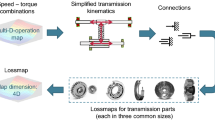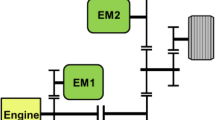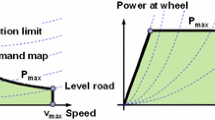Abstract
This paper presents a simulation methodology developed at the Institute of Automotive Engineering (IAE). With this simulation method, transmission lossmaps can be calculated for Dedicated Hybrid Transmission (DHT). These transmission lossmaps are considered within the control strategy section of a modular simulation model, which can lead to more realistic simulation results. Four DHT concepts are investigated using this simulation methodology: three multi-mode DHT (MM-DHT) transmission concepts and a Power Split DHT (PS-DHT) concept. All concepts have two electric machines (EM). The first concept is a MM-DHT, which was developed with the transmission synthesis of the IAE. This DHT concept has two planetary gear sets (PGS), four shifting elements, and two EM. The other MM-DHT concepts are based on the Voltec 2 and the CT6. They also have two EM. The Voltec 2 has two PGS and three shifting elements. The CT6 has three PGS and five shifting elements. The power split DHT has one PGS and no shifting elements. For the evaluation of the transmission concepts, consistent and representative performance requirements are first defined, which must be fulfilled by all concepts. Afterwards, the transmission losses of the individual concepts can be subdivided via the lossmap-based simulation model for the different loss components. Finally, the DHT concepts are examined and evaluated with regard to mechanical efficiency and fuel consumption in the WLTC.















Similar content being viewed by others
References
Seidel, T., Küçükay, F.: Practice-oriented determination of transmission efficiency. In: 9th International CTI Symposium. Novi, USA (2015)
Inderwisch, K.: Verlustermittlung in Fahrzeugantrieben. Shaker Verlag, Aachen (2015)
Lange, A., Li, L., Küçükay, F.: Evaluation and optimization of innovative hybrid drives. In: 5th CoFAT, Fürstenfeldbruck, (2016)
Serrao, L.: A comparative analysis of energy management strategies for hybrid electric vehicles’, Center for Automotive Research, The Ohio State University. J. Dyn. Syst. Meas. Control 133, 031012-1–031012-9 (2011)
Musardo, C., Rizzoni, G., Staccia, B. : A-ECMS: An Adaptive Algorithm for Hybrid Electric Vehicle Energy Management. In: Proceedings of the 44th IEEE Conference on Decision and Control, and the European Control Conference 2005, Seville, Spain, December 12-15, (2005)
Lange, A., Küçükay, F.: Potentials of predictive control strategies. In: CoFAT 2017, Fürstenfeldbruck, (2017)
Lange, A.: Optimierung Modularer Elektro- Und Hybridantriebe. Shaker Verlag, Aachen (2018)
Seidel, T., Lange, A., Küçükay, F.: DHT concepts based on DCT design. VDI Getriebesymposium, Bonn (2017)
Author information
Authors and Affiliations
Corresponding author
Ethics declarations
Conflict on interest
On behalf of all authors, the corresponding author states that there is no conflict of interest.
Additional information
Publisher's Note
Springer Nature remains neutral with regard to jurisdictional claims in published maps and institutional affiliations.
Rights and permissions
About this article
Cite this article
Hengst, J., Seidel, T., Lange, A. et al. Evaluation of transmission losses of various Dedicated Hybrid Transmission (DHT) with a lossmap-based simulation model. Automot. Engine Technol. 4, 29–36 (2019). https://doi.org/10.1007/s41104-019-00041-1
Received:
Accepted:
Published:
Issue Date:
DOI: https://doi.org/10.1007/s41104-019-00041-1




